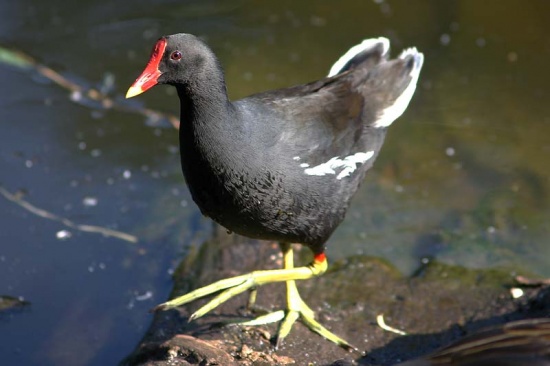- Gallinula chloropus
Identification
Length 30-36 cm; Mass 230-340 g (males larger than females).
Adult: Slaty black, except for a white under-tail and white streaks on the flanks. Eye red; bill red with a greenish-yellow tip; frontal shield red; legs and feet yellowish green with a red garter above the tarsal joint. The red shield and red bill with yellow tip are diagnostic (the Lesser Moorhen is smaller and has a yellow bill with red on the culmen and frontal shield only).
Immature: Above dark brown; below buffy, paler in centre of belly; iris grayish brown; bill and frontal shield greenish brown; legs and feet greenish, garter yellow.
Chick: Downy black; feathers around neck tipped white; skin above eye blue; bill red, tip yellow; small frontal shield red; legs and feet blackish brown.
Distribution
Common Moorhen is a species that occur almost World wide, with the notable exception of the Australasian area including New Zealand.
Widespread and generally very common bird in the Western Palearctic. Breeds from the British Isles and Iberia east to the Urals and Caspian Sea. In the north breeds around coastal Norway as far as about 66° N, in the southern half of Sweden and extreme south Finland. In the south breeds around the Mediterranean, on the Balearics, Corsica and Sardinia, Sicily, Crete, Cyprus and some of the Aegean islands and has bred on Malta. Also breeds at very scattered localities in the Canaries and northwest Africa, in the Nile Valley and in parts of western and southern Turkey, the Middle East and Iraq. Formerly bred on the Cape Verde Islands.
Populations from central Europe eastwards are migratory, wintering in southwest Asia or Africa, the remainder are resident or partially migratory. Also resident are small populations on Terceira and possibly Sao Miguel in the Azores, and a scarce but increasing resident on some of the Canary Islands.
Vagrant north to Svalbard, Iceland and the Faroes in the north and Madeira in the south.
Taxonomy
Tristan Moorhen, G. nesiotis (extinct) was formerly lumped within Common Moorhen.
Subspecies1
- G. c. chloropus - Palearctic; winters to Arabia and s China
- G. c. meridionalis - sub-Saharan Africa and St. Helena I.
- G. c. pyrrhorrhoa - Madagascar, Réunion, Mauritius and Comoro Islands
- G. c. orientalis - Seychelles, Andamans, Malay Pen., Indonesia and Philippines
- G. c. guami - N Marianas (Guam, Saipan, Tinian and Pagan)
- G. c. sandvicensis - Hawaiian Islands
- G. c. cachinnans - SE Canada to w Panama, Bermuda and Galapagos Islands
- G. c. cerceris - Greater and Lesser Antilles
- G. c. barbadensis - Barbados
- G. c. pauxilla - E Panama to n and w Colombia, arid w Ecuador and nw Peru
- G. c. garmani - Andes of Peru to Chile, Bolivia and nw Argentina
- G. c. galeata - Guianas to n Argentina, Uruguay and Brazil; Trinidad
Habitat
Virtually any kind of freshwater: marshlands and swamps, lakeshores and riverbanks, often in urban parks and sewage ponds. Frequently feeds on grass adjacent to water.
Behaviour
Often seen swimming and feeding while doing so, but also feeds during excursions up on e.g., lawns.
Breeding: Occurs in all months of the year; may rear up to 8 broods/year. The nest is a bowl of rushes and reeds concealed in dense aquatic vegetation well above the water level; built by both sexes. Clutch: 4-9 eggs (sometimes up to 11, possibly laid by 2 females). Eggs: Dark buff to grayish white, spotted, freckled and blotched with red-brown and slate; weigh about 25 g. Incubation: 21-22 days by both sexes; the female incubates only by day and the male incubates at night. Fledging: 40-50 days; young dependent on parents for 1-6 weeks after first flight.
Bird Song
<flashmp3>Gallinula chloropus (song).mp3</flashmp3>
Listen in an external program
References
- Clements James F. 2007. The Clements Checklist of Birds of the World. 6th ed., with updates to October 2008. Ithaca: Cornell University Press. ISBN 9780801445019




